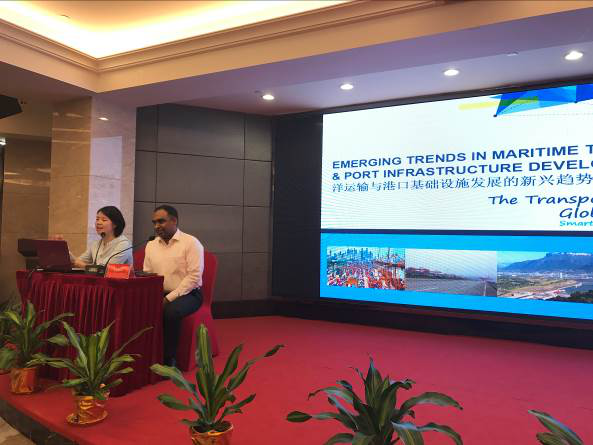‘Port Development and Operation’ Workshop
2017.05.19

ACTIVITY INTRODUCTION
The Bank team and MBHAB jointly conducted the training program on May 19, 2017 for the Meizhou Bay port community, which included government agencies, port operators, shipping and land transport companies among the stakeholder community. Two presenters/trainers presented the latest trends on the port development and operation, including:
1.Ninan Oommen Biju, Senior Port Specialist, the World Bank;
2.Wang Haixia, Researcher, China Waterway Transport Science Design Institute;


The training program presented the current scenario and emerging trends in the global maritime transport sector and its impact on port infrastructure developments, and covered
-the volume of global seaborne trade, which more than doubled in the last 20 years;
-the types of cargo transported and the segments where the volume growth were substantial, especially the bulk and the container shipments;
-deployment of larger size vessels in the dry bulk, tanker, liquefied natural gas (LNG), and container transport sectors, and its specifications;
-developments on the key shipping lanes with the enlargement of the Suez Canal and the Panama Canal, which has facilitated the deployment of large size vessels, and
-the development of port infrastructure based on the larger ship sizes, types of cargo, and the emerging patterns.
The deployment of larger size vessels across all types of carriers - dry cargo and containers as well as liquid and gas carriers, and the new building order book dominated by large size vessels, posed challenges to the existing port infrastructure. The bigger vessels with wider beam (60-65 meters) and deeper draughts (15-25 meters) have necessitated the upgrading and development of port infrastructure in most trade lanes.
It was highlighted that periodic review and analytical work on the freight flows and maritime trade was necessary to align the port infrastructure developments with the trading patterns that are emerging. Technological innovations, developments in maritime connectivity and electronic commerce are opening up new supply and demand areas. The analysis on the utilization of capacities at the top 30 ports in the world pointed to the development of port infrastructure based on the demand analysis and long range planning, the potential for cargo generation, and the role of the port for hinterland and regional connectivity.
The deployment of mega vessels also distinguished the mega ports and the regional gateway ports, with the shipping lines identifying some of the strategically located mega ports for transshipment of cargo destined or originated from the region. For this reason, it was important to “right-size” the port based on the volume of cargo generation, hinterland connectivity, and the regional multimodal networks through short sea feeders, inland waterways and railways.
The quality of the port infrastructure in the region as well as the need to upgrade the maritime infrastructure in the emerging countries were also presented, where there is large private participation in port infrastructure development.
The 13th five-year plan of waterway transport in China was introduced and discussed, and the strategy of the Meizhou bay development was discussed. The case studies of other ports in China which have been successfully transformed from the simple port operation to the advanced development involving the whole value chain.
It was also recommended that further analytical studies should be initiated to understand the new maritime trading patterns and identify the potential industrial clusters that could be developed to boost the utilization of the port facilities that are being developed. The development of industrial parks, logistics facilities and multimodal connectivity to expand the hinterland reach, based on the findings of the analytical study, would be key to enhancing the volume throughput as well as the economic development of the Meizhou Bay region.



